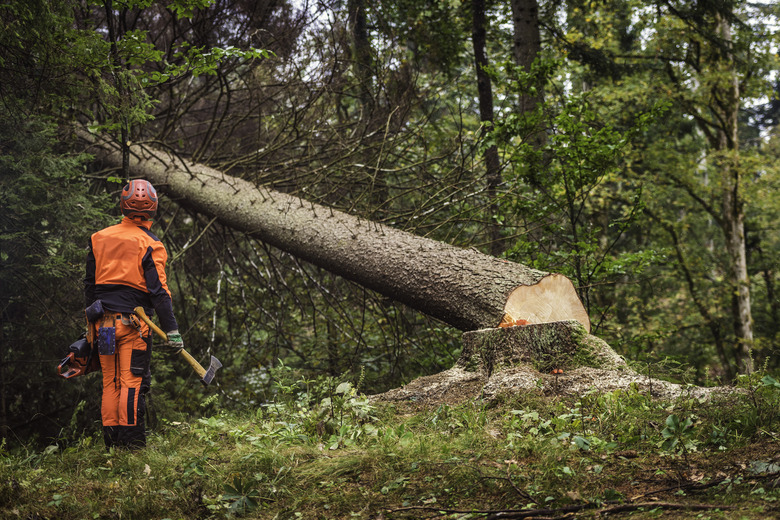Advanced Tree Felling Techniques
The traditional method of felling trees uses a simple notch and back-cut technique. While this method can work effectively to fell a tree in many cases, more advanced techniques may prove better choices if the growth of a tree warrants their use.
Foresters have the choice of a few technical tree felling techniques, and these can help bring down a tree in a safer manner.
Tree Felling Definition
Tree Felling Definition
Tree felling refers to removal and/or cutting down a tree by cutting at the base of the trunk of the tree.
Because you're cutting so low to the ground on the tree, this type of removal can be dangerous and requires advanced tree felling techniques in order to keep everyone involved safe and the surrounding area undamaged.
Types of Tree Felling Cuts: Bore Cut
Types of Tree Felling Cuts: Bore Cut
The traditional method of making a back cut involves cutting into the tree from the back. With leaning or larger diameter trees, this can lead to the danger of a "Barber Chair" developing, where the tree splits vertically up the trunk. Bore cuts provide a way to greatly reduce this danger.
Bore cuts use a chainsaw to drive a cut through the center of the trunk at right angles to the direction of fall. This leaves a section of trunk at the back intact to hold the tree upright. Cutting this on completion of the notch and back cut should release the tree to fall.
Felling Aids
Felling Aids
Felling aids can help bring down a tree that remains standing after the completion of a standard notch and back-cut. Typical aids available include metal breaking bars, which slip into the back cut and use human power to leverage the tree in the direction of the notch to fell it.
Tree felling wedges are placed into the back cut can help to hold the tree in place and stop it sitting back on the cut. Driving the tree felling wedges into the cut with a sledgehammer can also help in safely bringing down the tree in the correct direction.
Tree Driving
Tree Driving
Tree driving involves felling one tree into another to help bring them both down. It's used for trees that have fallen and gotten caught up in branches, partially cut trees that have sat back onto the cut or to push a tree against its natural lean.
The driving tree must have sufficient height and weight to take the second tree down, and should ideally have a natural lean that makes it suitable to fall toward the other tree.
Back Pulling
Back Pulling
Back pulling involves felling a tree against its natural lean. This can help to drop a tree away from a property location, overhead lines, or to position it more suitably for processing. Back pulling typically involves the use of a winch system to haul the tree against its natural lean.
A direct pull setup has the winch set up at least two tree lengths behind the tree, although in more confined spaces a winch-and-block system may better help position the winch. Attaching the rope as high as possible up the tree, better controls the direction of fall.
Crane Removal
Crane Removal
In urban areas, the conventional method of felling a tree in one piece may prove difficult due to surrounding property and infrastructure. Options for tree felling in these areas include crane removal.
This typically involves felling the tree piece-by-piece, with the weight of a large section secured by the crane prior to cutting. This can greatly reduce the chances of damage to property.
Cite This Article
MLA
Farquharson, Ian. "Advanced Tree Felling Techniques" sciencing.com, https://www.sciencing.com/advanced-tree-felling-techniques-8611141/. 22 November 2019.
APA
Farquharson, Ian. (2019, November 22). Advanced Tree Felling Techniques. sciencing.com. Retrieved from https://www.sciencing.com/advanced-tree-felling-techniques-8611141/
Chicago
Farquharson, Ian. Advanced Tree Felling Techniques last modified March 24, 2022. https://www.sciencing.com/advanced-tree-felling-techniques-8611141/
